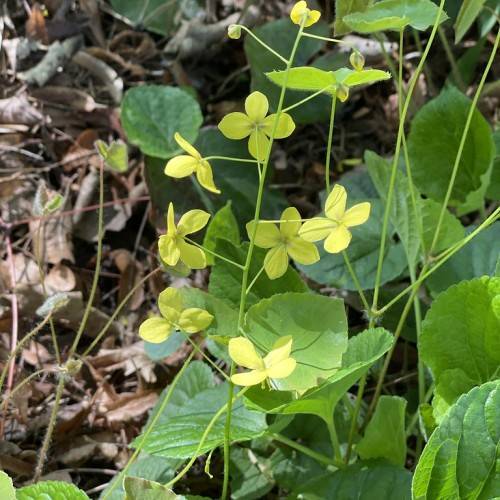
bishop's hat
Epimedium perralderianum
Cycle:
Herbaceous Perennial
Watering:
Minimum
Hardiness Zone:
5 - 9
Flowers:
Flowers In Spring
Sun:
Part shade,full shade
Leaf:
Yes
Growth Rate:
Low
Maintenance:
Low
Salt Tolerant:
Yes
Care Level:
Medium
watering
Bishop's hat (Epimedium perralderianum) is a hardy, evergreen perennial that requires patience and moderate care to thrive. To water this plant species correctly, you should provide it with consistent moist but not soggy soil, aiming to water it about once a week. During summer months when temperatures are higher and the risk of drying out increases, you should water every 5-7 days. In Spring and Autumn, it may be necessary to water every 10-14 days. When watering, ensure that the soil receives enough water to adequately moisten it, but avoid overwatering. In the winter months, when the plant is dormant, Bishop's hat should still be watered occasionally, about once or twice a month.
sunlight
Epimedium perralderianum, commonly known as bishop's hat, requires partial sun to partial shade conditions, meaning that the plant benefits from a few hours of direct sunlight each day, but not too much exposure to sunlight. The ideal amount of sunshine for this species is 4-6 hours of morning or late afternoon sun, with a shaded location for the remainder of the day. This plant does not do well in intense, long periods of direct sun and too much exposure could lead to the plant drooping or wilting. Bishop's hat is relatively cold hardy and can be grown in USDA zones 4-9.
pruning
Bishop's hat (Epimedium perralderianum) should be lightly pruned in late February or early March to remove any dead or damaged foliage. Pruning should be done lightly with clean, sharp pruning shears or hand pruners, and only the new growth from the previous season should be cut back. This light pruning will encourage the plant to grow more shoots and will help to give the plant a more compact shape. In the fall, annual deadheading should be done to keep Bishop's hat looking its best. Some may find that hard pruning is necessary to control the size of Bishop's hat, however, this should only be done in moderation and no more than 1/3 of the plant's foliage should be removed in any given year.
